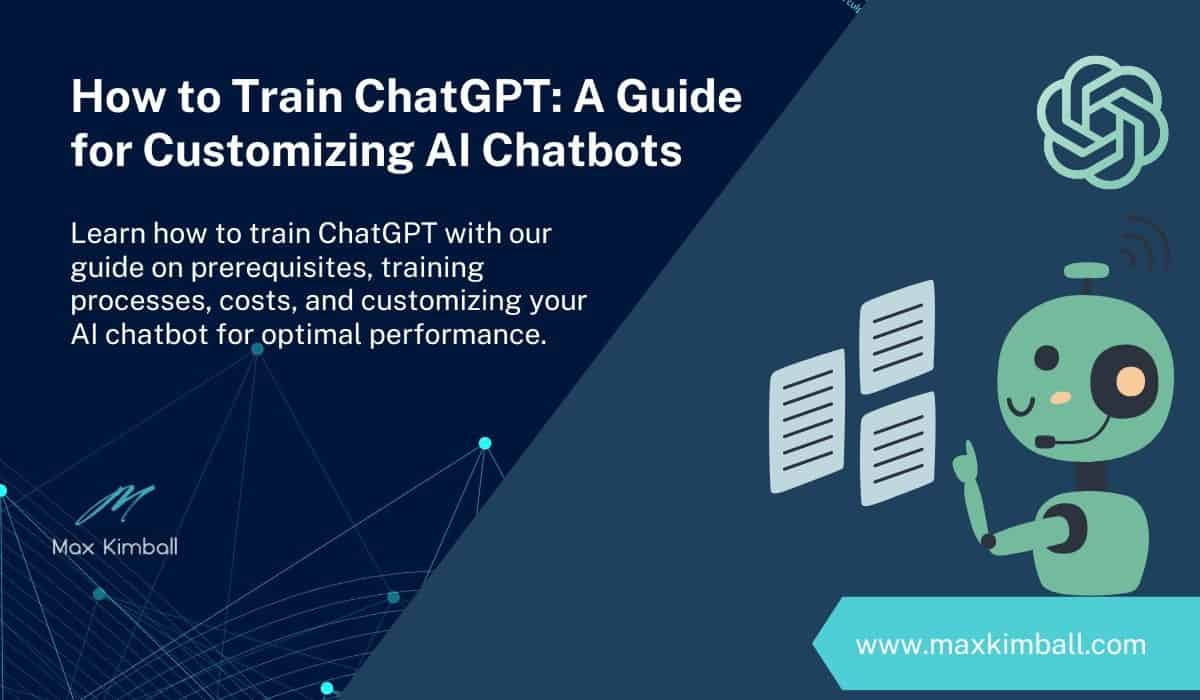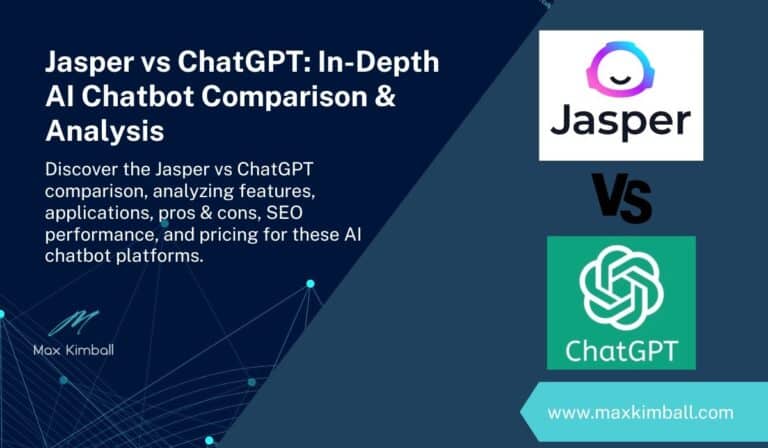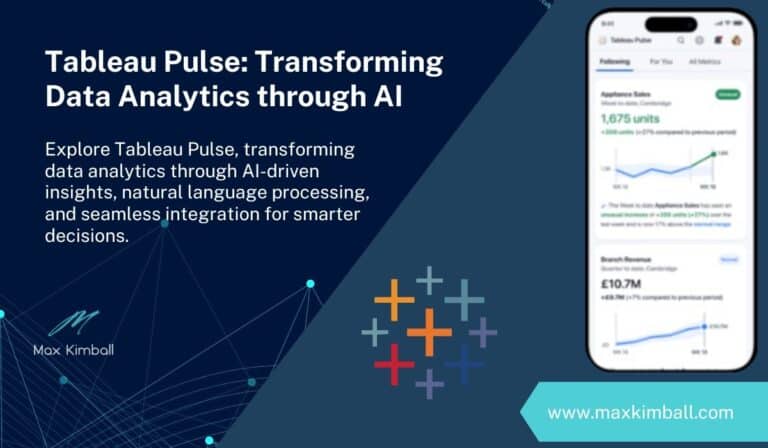How to Train ChatGPT: A Guide for Customizing AI Chatbots

Learning how to train ChatGPT is an essential skill for those who want to harness the power of advanced AI chatbots. In this blog post, we will delve into the intricacies of training ChatGPT and explore ways to create custom AI solutions that cater to your specific needs.
We’ll begin with a brief overview of ChatGPT, followed by the prerequisites you need in order to start training your own model. Next, we will guide you on how to train ChatGPT using your own data sets, allowing you to build a robust knowledge base tailored specifically for your application or industry requirements.
Finally, we’ll discuss the step-by-step process involved in training ChatGPT and highlight factors affecting its cost. By understanding these key aspects, you can effectively leverage this cutting-edge technology and elevate your chatbot’s capabilities.
Table of Contents:
- Overview of ChatGPT
- Training ChatGPT
- Setting Up ChatGPT
- Prerequisites for Training ChatGPT
- Training Process for ChatGPT
- Cost of Training ChatGPT
- Train ChatGPT on Your Own Data
- FAQs in Relation to How to Train Chatgpt
- Conclusion
Overview of ChatGPT
In today’s fast-paced business environment, the need for efficient and effective communication has never been more critical. Enter ChatGPT, a powerful AI-driven tool designed to increase productivity and provide innovative solutions to businesses across various industries.
Developed by OpenAI, ChatGPT is an advanced language model that utilizes Generative Pre-trained Transformer (GPT) technology. It can generate human-like text responses based on given prompts, making it ideal for tasks such as customer support, content creation, code generation, and much more.
- Natural Language Processing: With its ability to understand context and generate relevant responses in natural language format, ChatGPT enables seamless interactions between humans and machines.
- Versatility: The applications of this cutting-edge technology are vast – from drafting emails or articles to answering questions about specific products or services.
- Data-driven insights: By analyzing large volumes of data quickly and accurately, ChatGPT can help businesses make informed decisions backed by real-time information.
To harness the full potential of this revolutionary AI tool in your organization’s operations or projects, it is essential to understand how to train ChatGPT effectively. In this blog post series, we will guide you through the process step-by-step: from the prerequisites needed for training all the way up until deploying your own custom-trained models.
Setting Up ChatGPT
Setting up ChatGPT involves downloading the setup file and installing it on your system. Once you have done this, you can begin using ChatGPT to train your custom AI chatbot.
Overall, training ChatGPT is a complex process that requires a deep understanding of the technology and its applications. However, with the right knowledge and tools, you can create a custom AI chatbot that can revolutionize the way your organization communicates and operates.
ChatGPT is a powerful AI tool that can help businesses increase their productivity and solve problems. However, training ChatGPT requires some prerequisites to be met in order for it to work properly.
Prerequisites for Training ChatGPT
Before diving into the process of training ChatGPT, it’s essential to understand the prerequisites needed to ensure a smooth and successful experience. In this section, we will discuss hardware requirements, software requirements, and data sets necessary for training ChatGPT.
Training ChatGPT first requires a ChatGPT API key, a ChatGPT model, and a knowledge base.
Hardware Requirements
To train an AI model like ChatGPT effectively, you need powerful computing resources. It is recommended to use NVIDIA GPUs, as they offer excellent performance in handling large-scale machine learning tasks. A high-end GPU with at least 16GB VRAM is ideal; however, using multiple GPUs or even cloud-based services like Amazon AWS P3 instances can significantly speed up the training process.
Software Requirements
- TensorFlow: TensorFlow is an open-source machine learning framework developed by Google that provides tools for building and deploying ML models such as GPT-2 or GPT-3. You can download TensorFlow from their official website.
- Hugging Face Transformers: Hugging Face offers a popular library called “Transformers,” which includes pre-trained models and utilities required for fine-tuning language models like GPT-2 or GPT-3 on custom datasets. Visit their GitHub repository to get started.
- An Integrated Development Environment (IDE): An IDE like Visual Studio Code or PyCharm will be helpful for writing and managing your code during the training process.
- Python: Ensure that you have Python 3.6 or later installed on your system, as it is required to run TensorFlow and Hugging Face Transformers libraries. Download the latest version of Python from their official website.
Data Sets
A large dataset is crucial for effectively training ChatGPT. You can use publicly available datasets such as the WebText dataset by OpenAI, which contains a diverse range of internet text sources. Alternatively, you may also create your own custom dataset based on specific domains or industries relevant to your business needs.
In the following section, we will walk through the steps of training ChatGPT with these prerequisites in mind, emphasizing high perplexity and increased randomness.
Having a basic understanding of the principles and algorithms behind ChatGPT is essential for successful training. With that knowledge, we can now move on to discussing the actual process of training ChatGPT.
Before training ChatGPT, it is important to have powerful computing resources such as NVIDIA GPUs and software requirements like TensorFlow and Hugging Face Transformers. A large dataset, either publicly available or custom-made, is also crucial for effective training.
Training Process for ChatGPT
In this section, we will explore the steps required to train ChatGPT and create a powerful AI model that can improve efficiency and provide solutions for your business.
Step 1: Prepare Your Dataset
To begin with, gather a large dataset containing text conversations relevant to your domain. This data should be cleaned and preprocessed to remove any inconsistencies or errors. You may use publicly available datasets like Conversational AI Datasets, or create one using your own resources.
Step 2: Tokenize Your Data
Next, tokenize the text in your dataset into smaller units called tokens. These tokens represent words or subwords which are used as input for the GPT model during training. Use libraries such as Hugging Face Transformers to perform tokenization efficiently.
Step 3: Set Up Hardware & Software Requirements
- Hardware: Ensure you have access to high-performance GPUs (such as NVIDIA Tesla V100) for efficient training of large models like ChatGPT.
- Software: Select an appropriate deep learning framework (e.g., TensorFlow or PyTorch) and install necessary packages/libraries required for GPT-based models.
Note:
Fine-Tuning Process for ChatGPT
While training ChatGPT from scratch is resource-intensive and may not be feasible for most users, you can fine-tune pre-trained models like OpenAI’s GPT-3 on your specific dataset to achieve better results.
Fine-Tuning Process:
- Create a Custom Dataset: Combine your tokenized data with the base model’s existing tokens to create a custom dataset for fine-tuning.
- Select Hyperparameters & Model Architecture: Choose appropriate hyperparameters (e.g., learning rate, batch size) and model architecture based on your requirements and available resources.
- Fine-Tune the Model: Train the ChatGPT model using gradient descent optimization on your custom dataset. Monitor loss metrics during training to ensure convergence towards an optimal solution.
The duration of this process depends upon various factors such as hardware capabilities, dataset size, and chosen hyperparameters. With proper planning and execution, you can successfully train ChatGPT tailored specifically for your business needs.
Training ChatGPT is a cost-effective and efficient way to increase productivity for businesses. By understanding the costs associated with training, businesses can make informed decisions about how best to utilize this AI software.
This section outlines the step-by-step process of training ChatGPT, an AI model that can enhance productivity and provide solutions for businesses. The process involves preparing a dataset, tokenizing data, setting up hardware and software requirements, and fine-tuning pre-trained models like OpenAI’s GPT-3 on a custom dataset to achieve better results. With proper planning and execution, users can successfully train ChatGPT tailored specifically for their business needs.
Train ChatGPT on Your Own Data
Training ChatGPT on your own data can help you create a customized AI model that caters to the specific needs of your business. In this section, we will discuss how to train ChatGPT using your unique dataset and provide valuable insights into the process.
A. Preparing Your Dataset
The first step in training ChatGPT with your data is preparing a clean and well-structured dataset. This includes:
- Gathering relevant text data from various sources such as customer interactions, emails, or other documents.
- Cleaning and preprocessing the data by removing irrelevant information, fixing typos, and ensuring proper formatting.
- Splitting the dataset into training and validation sets for optimal performance during model evaluation.
B. Fine-tuning OpenAI’s GPT Model
To train ChatGPT on your custom dataset, you’ll need access to an existing GPT-based model like OpenAI’s GPT-2 or GPT-3 models which are available through their API service (OpenAI Beta API). Follow these steps for fine-tuning:
- Create an account at OpenAI platform if you haven’t already done so.
- Familiarize yourself with their API documentation (OpenAI Docs) to understand how it works and its limitations before proceeding further.
- Select one of their pre-trained models (e.g., “text-davinci-002” for GPT-3) based on your requirements in terms of size, performance, and cost.
- Use the API to fine-tune the selected model on your dataset by providing appropriate parameters such as learning rate, batch size, and training epochs. Monitor progress closely to ensure that you’re not overfitting or underfitting your data.
C. Evaluating Model Performance
Once you have trained ChatGPT on your custom dataset, it’s essential to evaluate its performance using metrics like accuracy or F1 score. This will help pinpoint any problems with the model and make necessary modifications before putting it into use in a live setting.
In summary, training ChatGPT on your own data involves preparing a clean dataset, fine-tuning an existing GPT-based model from OpenAI using their API service, and evaluating the resulting customized AI solution for optimal performance tailored specifically for your business needs.
Train ChatGPT on your own data to create a customized AI model that caters to the specific needs of your business. Prepare a clean and well-structured dataset, fine-tune an existing GPT-based model from OpenAI using their API service, and evaluate the resulting customized AI solution for optimal performance tailored specifically for your business needs.
Cost of Training ChatGPT
The cost associated with training ChatGPT can vary depending on several factors, such as the hardware and software requirements, data sets used for training, and any additional tools or resources needed to optimize the model. In this section, we’ll delve into the associated expenses for training ChatGPT, including hardware and software requirements, data sets used to train it and any extra tools or resources necessary to optimize its performance.
Hardware Costs
To train a powerful language model like ChatGPT effectively, you need access to high-performance computing resources. This typically involves using NVIDIA GPUs, which are designed specifically for deep learning tasks. The cost of purchasing these GPUs can be quite expensive; however, an alternative is renting GPU instances from cloud service providers like Amazon Web Services (AWS) or Google Cloud Platform (GCP). These services offer pay-as-you-go pricing models that allow you to scale your resource usage based on your needs.
Software Costs
In addition to hardware expenses, there may also be software costs involved in training ChatGPT. While certain advanced features or support packages may necessitate paid subscriptions, many well-known machine learning frameworks such as TensorFlow and PyTorch are available for free.
Data Set Expenses
A crucial aspect of training a language model is having access to large-scale text corpora for pre-training purposes. Although there are numerous publicly available datasets such as Common Crawl and Wikipedia dumps, some organizations may need to purchase or license proprietary data sets for specific use cases. The cost of these datasets can vary significantly depending on the size, quality, and relevance of the content.
Training Time Costs
The time it takes to train ChatGPT is another factor that contributes to its overall cost. Training a large-scale language model like ChatGPT can take several days or even weeks, depending on your hardware setup and dataset size. This prolonged training period not only increases cloud service usage fees but also affects human resources costs as engineers spend time monitoring and fine-tuning the process.
In summary, while there are numerous variables that influence the total cost of training ChatGPT, understanding each component’s impact will help you make informed decisions about resource allocation for your project.
The cost of training ChatGPT is an important factor to consider when deciding whether or not to implement the technology. Let’s explore ways to teach ChatGPT using one’s own data, while keeping perplexity and randomness at a high level.
Training ChatGPT can be expensive due to hardware, software, and data set expenses. High-performance computing resources like NVIDIA GPUs are required for effective training, and cloud service providers offer pay-as-you-go pricing models. Additionally, the time it takes to train ChatGPT can take several days or even weeks, increasing costs further.
FAQs in Relation to How to Train Chatgpt
How to Train Data in ChatGPT?
To train data in ChatGPT, follow these steps:
- Gather a large dataset of text conversations.
- Preprocess the data by tokenizing and cleaning it.
- Fine-tune the model using gradient descent optimization on your dataset.
- Regularly evaluate the performance of your model during training.
For more details, refer to OpenAI’s GPT-2 repository.
How to Use ChatGPT Effectively?
To use ChatGPT effectively, ensure that you provide clear context and specific prompts. Experiment with different phrasings if needed. Utilize system-level instructions for better control over responses. Continuously monitor its output quality and iteratively fine-tune it based on feedback from users or domain experts.
How to Train a Chatbot?
Train a chatbot by following these steps:
- Collect conversation datasets relevant to your domain.
- Clean and preprocess the data.
- Choose an appropriate algorithm like Transformer-based models such as GPT-2/3 or BERT.
- Train the model using supervised learning techniques with labeled examples or reinforcement learning methods for interactive tasks.
What Algorithm Does ChatGPT Use?
ChatGPT is an AI-powered chatbot that can be trained to provide personalized responses based on the user’s input. The algorithm used by ChatGPT is a combination of several natural language processing (NLP) techniques, including:
- Transformer architecture: This allows the model to understand and generate text in a more efficient manner.
- GPT-3: The third iteration of OpenAI’s Generative Pre-trained Transformer, which provides state-of-the-art performance for NLP tasks.
- Fine-tuning: This involves training the model on specific data sets or tasks to improve its accuracy and effectiveness for those particular use cases.
Conclusion
Training ChatGPT can seem daunting, but with the right prerequisites and training process, it is achievable. Understanding the overview of ChatGPT and its capabilities is crucial to successful training. Additionally, being prepared with the necessary resources and knowledge will make for a smoother experience.
If you’re interested in learning how to train ChatGPT or want help with other AI-related projects, visit Max Kimball’s website today!



